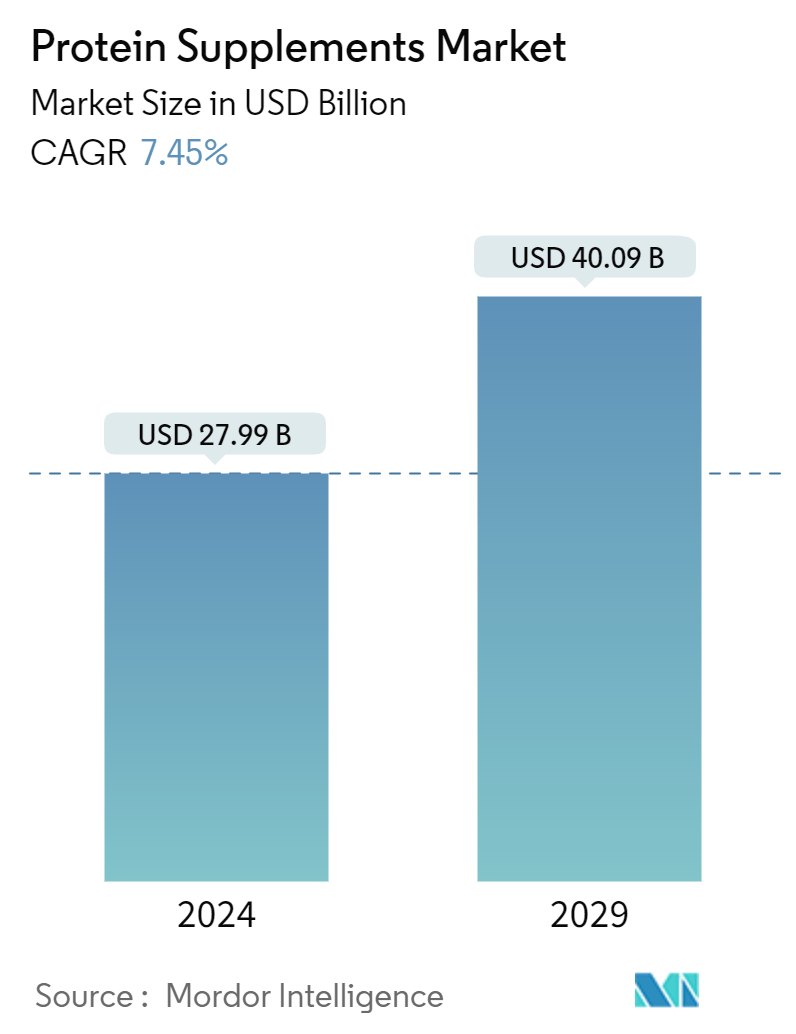Market Size of Protein Supplements Industry

| Study Period | 2019 - 2029 |
| Market Size (2024) | USD 27.99 Billion |
| Market Size (2029) | USD 40.09 Billion |
| CAGR (2024 - 2029) | 7.45 % |
| Fastest Growing Market | Asia-Pacific |
| Largest Market | North America |
Major Players.webp)
*Disclaimer: Major Players sorted in no particular order |
Protein Supplements Market Analysis
The Protein Supplements Market size is estimated at USD 27.99 billion in 2024, and is expected to reach USD 40.09 billion by 2029, growing at a CAGR of 7.45% during the forecast period (2024-2029).
Protein supplements are popular among gym fanatics and fitness enthusiasts, as they influence various aspects of the body, such as muscle growth, metabolism, energy levels, heart health, and weight management. The diversity of protein supplements, in terms of claims, content, sources, forms, and flavors, caters to a vast global consumer group and actively drives the market. Additionally, the increasing demand for plant-based protein is expected to push manufacturers to bring organic and clean-label protein supplements across the market channels. Furthermore, the rising prominence of physical activities, international sports, and fitness events promotes the consumption of protein supplements, as protein is a vital ingredient in maintaining physical health. Social media influencers and various government initiatives and campaigns encourage consumers to participate in multiple fitness and sports-related activities, thus contributing to the increasing expenditure on maintaining a healthy lifestyle. Besides this, as protein is present in small amounts in fruits and vegetables, the rising vegan population is shifting toward protein supplements to meet their dietary requirement.
Protein Supplements Industry Segmentation
Protein supplements are processed, refined protein products available in various forms, ranging from powders to bars to drinks. Athletes and individuals use these products extensively as dietary supplements to increase muscle mass, enhance recovery, and boost overall performance.
The global protein supplements market is segmented by form, source, distribution channel, and geography. By form, the market is segmented into powder, bars, ready-to-drink, and other forms. By source, the market is segmented into animal-based and plant-based. By distribution channel, the market is segmented into supermarkets & hypermarkets, online retail stores, health and wellness stores, and other distribution channels. By geography, the market is segmented into North America, Europe, Asia-Pacific, South America, and Middle East & Africa.
The market sizing has been done in value terms in USD for all the abovementioned segments.
| Form | |
| Powder | |
| Ready To Drink | |
| Bars | |
| Other Forms |
| Source | |
| Animal-based | |
| Plant-based |
| Distribution Channel | |
| Supermarkets & Hypermarkets | |
| Online Retail Stores | |
| Health and Wellness Stores | |
| Other Distribution Channels |
| Geography | |||||||||
| |||||||||
| |||||||||
| |||||||||
| |||||||||
|
Protein Supplements Market Size Summary
The protein supplements market is experiencing significant growth, driven by the increasing popularity of protein as a key macronutrient among diverse consumer groups, including fitness enthusiasts, athletes, and those seeking to maintain a healthy lifestyle. The market is characterized by a wide range of products that cater to various dietary preferences and needs, such as plant-based and organic options, which are gaining traction due to the rising vegan population. The influence of social media, government initiatives, and the growing prominence of physical activities and sports events are further propelling the demand for protein supplements. Companies are responding to this demand by innovating and expanding their product offerings, including ready-to-drink options and protein bars, to meet the evolving preferences of consumers.
Regionally, Asia-Pacific is poised to hold a significant share of the market, with China leading the growth due to government support for sports and fitness activities. The Indian market is also witnessing continuous innovation in product formulations and formats, catering to the preferences of young consumers with rising disposable incomes. The global protein supplements market is fragmented, with key players investing in research and development, expanding distribution channels, and forming strategic partnerships to enhance their market presence. These companies are focusing on developing products that align with the tastes and preferences of the new-generation customers, ensuring they remain competitive in a rapidly evolving market landscape.
Protein Supplements Market Size - Table of Contents
-
1. MARKET SEGMENTATION
-
1.1 Form
-
1.1.1 Powder
-
1.1.2 Ready To Drink
-
1.1.3 Bars
-
1.1.4 Other Forms
-
-
1.2 Source
-
1.2.1 Animal-based
-
1.2.2 Plant-based
-
-
1.3 Distribution Channel
-
1.3.1 Supermarkets & Hypermarkets
-
1.3.2 Online Retail Stores
-
1.3.3 Health and Wellness Stores
-
1.3.4 Other Distribution Channels
-
-
1.4 Geography
-
1.4.1 North America
-
1.4.1.1 United States
-
1.4.1.2 Canada
-
1.4.1.3 Mexico
-
1.4.1.4 Rest of North America
-
-
1.4.2 Europe
-
1.4.2.1 United Kingdom
-
1.4.2.2 Germany
-
1.4.2.3 France
-
1.4.2.4 Italy
-
1.4.2.5 Russia
-
1.4.2.6 Spain
-
1.4.2.7 Rest of Europe
-
-
1.4.3 Asia-Pacific
-
1.4.3.1 China
-
1.4.3.2 Japan
-
1.4.3.3 India
-
1.4.3.4 Australia
-
1.4.3.5 Rest of Asia-Pacific
-
-
1.4.4 South America
-
1.4.4.1 Brazil
-
1.4.4.2 Argentina
-
1.4.4.3 Rest of South America
-
-
1.4.5 Middle East & Africa
-
1.4.5.1 Saudi Arabia
-
1.4.5.2 South Africa
-
1.4.5.3 Rest of Middle East & Africa
-
-
-
Protein Supplements Market Size FAQs
How big is the Protein Supplements Market?
The Protein Supplements Market size is expected to reach USD 27.99 billion in 2024 and grow at a CAGR of 7.45% to reach USD 40.09 billion by 2029.
What is the current Protein Supplements Market size?
In 2024, the Protein Supplements Market size is expected to reach USD 27.99 billion.

